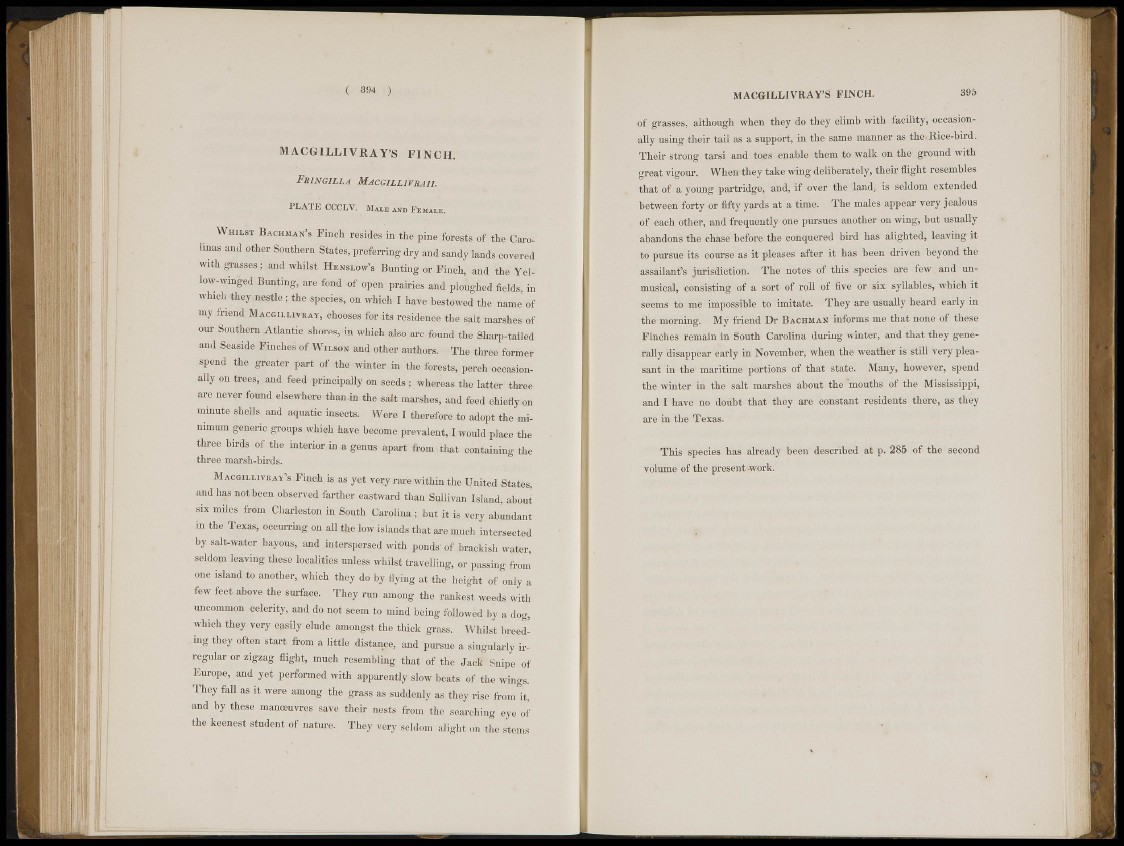
( 394 )
M AC G X IiXjI V K A Y'S FINCH.
FèimiLLA MACaiLLÏVSAII.
PL Al F CCOLV Maud anii Hhkaik.
Whilst B a c hWs Pinch r«S»ês in the pine ïbregfe; ^ t h é Cfeol
m a s , » p t h e r Southern States, p r e f e r r i n g and sandy lands .coWjisf
mth I^s e s i , and whilst Henslow's Hunting ..r l-nich, ami the ïel -
low-winged Bunting, fee fond of open prairie., an.l ploughed fields in
which thov.iiestlo ; the .species, oh: which I have bestowed the name of
my friend Ma coiu, ,««, ft,r ite rterAmco tho salt marshes of
our Southern .Atlantic shores, in which ^s® fee found the Sharp-tailed
anâ: Seaside Pinches of XVu.sc.x „„<1 other authors. The three: former
spefld the greater part of the .winter-in the forests, perch occ^ioually
on trees,. and feed principally on sued« ; whereas the latter three
aseaever found elsewhere than.in the salt marshes, and feed .chiellyon
minufe.sholl.s and aquatic insecte. fee I therefore to adopt the minimum
generic groups :whi«h have become prevalent, 1 would place the
three birds of the inter« in a genus apart, from that cmumiug the
three marsh-birds.
-M Acr.n.i.ivuAi*s,Kini'h is as yet very rare within the United States,,
and has riot been observed farther e:a|tssifed than Sullivan Island, about
* miles from Charleston in South Carolina; but it ib.vorv/al.Hti.lant
in the Texas, occurria;.' on all the Jo»-islands that are much intersected
by salt-water bayous, and interspersed with ponds of brackish water,
seMom leaving these localities unless whilst travelling, or passing from
0110 i s l a u d t 0 mother, which they d p y flying at the ha$pit of only a
few feet; above the surface. They run among the rankest W e d s with
uncommon ¡eelerity, and do not seem to mind being followed by a dog,
Whieh «hey very easily elude amongst the thick grass. Whilst breedo
f t e n s t a r ' fr»"> M e distance, and pursue a singularly irregular
or zigzag flight, much resembling that of the Jack gfipe of
Europe:,, and yet performed T^ith; .apparently slow béats of the wings.
They fall: as it were among the grass as suddenly as thoy rise from it,
and by these manoeuvres save their nests from the searching oyo of'
the keenest student of nature. They yeiy seldom alight on the stems
MACGILLIVRAY'S FINCH. 395
of grasses, although when they do they climb with facility, occasionally
using their tail as a support, in the same manner a» the-Bice-bird.
Their strong tarsi: and toes enable them to walk on the ground with
great vigour, Wheffi they take wing deliberately, their flight resembles
that of a young partridge, and, if over the land, is seldom extended
between forty or fifty yards at a time. The males appear very jealous
b'f each other, and frequently oiks pursues another on wing, but usually
abandons the chase before the conquered bird has alighted, leaving it
to pursue its course as it pleases after it has been driven beyond the
assailant^ jurisdiction. The notes of this species are few. and unmusical,
consisting of a sort of roll of five or six syllables) which it
seems to me impossible to imitate. They are usually heard early in
the morning. My friend Dr Bachman informs me that none of these
•tnfihes remain in South Carolina during winter, and that they generally
tfisappe'fe early S I November, when the weather is still very pleasant
in the maritime portions of that state. Many, however, spend
the Winter in the salt marshes about the mouths of the Mississippi,
and I have no doubt that they are constant residents there, as they
are in the Texas.
This species has already been described at p. 285 of the second
volume of the present work.